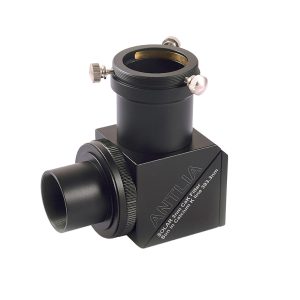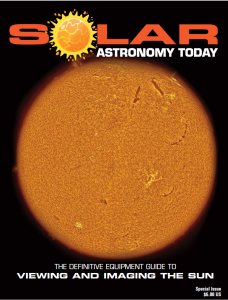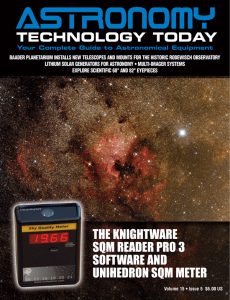The Antlia Solar Wedge offers a Herschel Wedge design which replaces the standard prism diagonal at the rear of refractor telescopes to enable imaging of solar granulation and sunspots.
 The Herschel Wedge design is well known to give sharper, higher-contrast images while transmitting a greatly reduced, safe amount of light to your imaging system. The image brightness can be conveniently increased or decreased using a control ring with aperture blades, similar to that used in camera lenses.
The Herschel Wedge design is well known to give sharper, higher-contrast images while transmitting a greatly reduced, safe amount of light to your imaging system. The image brightness can be conveniently increased or decreased using a control ring with aperture blades, similar to that used in camera lenses.
The Antlia Solar Wedge is produced using CNC machining offering optical components that are multi-coated with anti-reflection coatings to minimize internal reflections and contrast reducing stray light. The solar wedge incorporates an Antlia 3nm narrow bandpass filter at the Calcium II K-Line centered on 393.3nm and mounted in a standard 1.25’’ holder.
Unlike some other solar wedge designs which may get too hot during use, the Antlia Solar Wedge directs energy into an extra thick Polycrystalline Ceramic diffuser plate at the rear of the wedge. In addition, cooling vents above the ceramic plate facilitate efficient cooling of the system.
The internal Antlia CaK 3nm solar prism system provides for the safe management of harmful light intensity and heat when imaging the Sun. The system is comprised of a prism, CAK lens filter, Sun centering finder and a heat dissipation system. The Sun’s light passes through the right-angle prism and excess heat is transferred to the rear fins that act as a heat sink for cooling the instrument. This heat management system effectively keeps the instrument at safe operating temperatures
The Antlia Solar Wedge prism and internal CaK solar filter are made of heat resistant double-polished substrate. The Antlia CaK 393.3nm solar filter uses advanced multicoating to produce a sharp 3nm narrow bandpass, designed to maximize contrast for high-resolution imaging of Sun spots, solar surface granulation and other features that are prominent in CaK light.
A high blocking specification of OD5 (0.001%) between 200-1200nm wavelengths and OD3 (0.1%) between 1200-1500nm wavelengths delivers superb resolution for imaging with the Antlia Cak 3nm solar filter. It should be noted that the bandpass for Cak (393nm) makes solar features almost invisible to human vision because of the eye’s low sensitivity and poor resolving ability at the CaK frequency. Hence, the Antlia Solar Wedge with CaK filter is not recommended for visual observation. It is designed for imaging with cameras that have spectral responses well beyond human vision.
The Antlia Solar Wedge specifications and features include:
– Herschel 35mm prism
– Integrated ceramic heat dispersion diffuser
– Sharp CaK 3nm 393.3nm solar filter screwed into eyepiece holder base
– High-resolution imaging of granulation, sunspots, and other features-
– Includes a brightness control, a solar finder and effective heat dissipation system
– Anti Reflection (AR) coated prism and solar filter
– High blocking specification to reject solar heat ingress
– Sturdy CNC machined construction
– The wedge is intended for imaging only and is not suitable for visual observation.
– The wedge is not intended for solar prominence imaging and visual.
– The wedge must only be used with refractor telescopes to avoid damage to the unit.
– Refractor aperture must be no larger than 120mm or, focal ratio of F5.5 or longer.
You can learn more at www.antliafilter.com.

 The Sun is more active than its been in years and we have the Annular Solar Eclipse on October 14, 2023 and the Total Solar Eclipse on April 8, 2024! If you’d like to learn more about the technology behind solar observing, solar imaging and more, you can check out our free publication, “The Definitive Guide to Viewing and Imaging the Sun”. You don’t have to sign up or provide any information, simply click here and enjoy reading!
The Sun is more active than its been in years and we have the Annular Solar Eclipse on October 14, 2023 and the Total Solar Eclipse on April 8, 2024! If you’d like to learn more about the technology behind solar observing, solar imaging and more, you can check out our free publication, “The Definitive Guide to Viewing and Imaging the Sun”. You don’t have to sign up or provide any information, simply click here and enjoy reading!
And if you want to learn more about telescopes and more products used in amateur astronomy you will enjoy the extensive news, articles and reviews that are only available in the magazine pages of Astronomy Technology Today. We are offering a 1-year magazine subscription for only $6! Or, for an even better deal, we are offering 2 years for only $9. Click here to get these deals which only will be available for a very limited time. You can also check out a free sample issue here.

